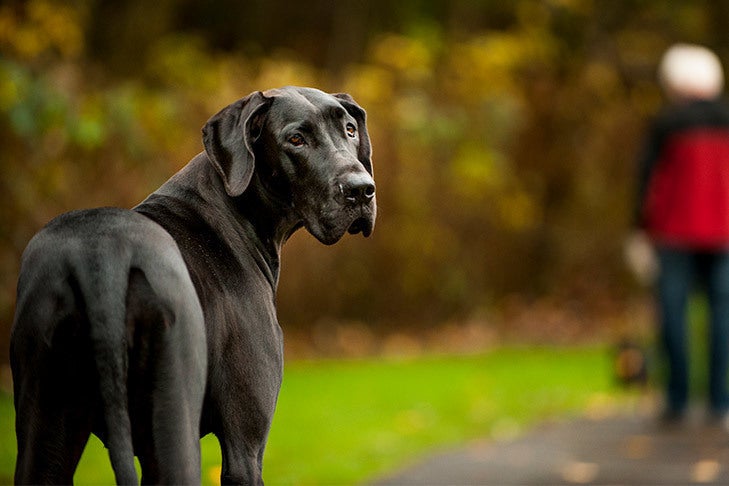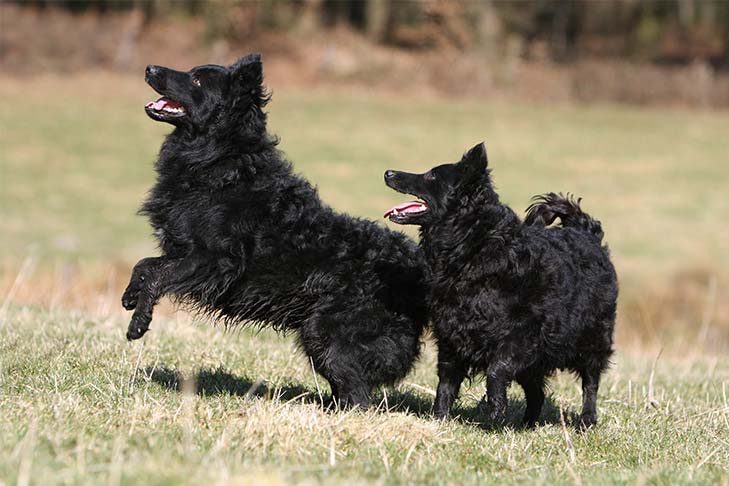what to do for hip dysplasia in dogs
Hip dysplasia. These two words terrify large and behemothic breed dog owners, but the truth is hip dysplasia can happen to whatsoever size or breed of domestic dog. This painful condition can drastically reduce a canis familiaris's quality of life and is hard for owners to watch. The good news is that embracing responsible dog ownership and educating yourself about potential health conditions like hip dysplasia can get a long way toward keeping your domestic dog comfortable.
Larn what all dog owners should know about hip dysplasia, including the symptoms, treatment options, and preventative measures you can take to keep your domestic dog healthy, happy, and active.
What Is Canine Hip Dysplasia?
Hip dysplasia is a mutual skeletal condition, ofttimes seen in large or giant brood dogs, although it can occur in smaller breeds, also. To sympathize how the status works, owners start must understand the basic beefcake of the hip joint.
The hip joint functions as a ball and socket. In dogs with hip dysplasia, the ball and socket do not fit or develop properly, and they rub and grind instead of sliding smoothly. This results in deterioration over time and an eventual loss of function of the articulation itself.
What Causes Hip Dysplasia in Dogs?
Several factors atomic number 82 to the development of hip dysplasia in dogs, beginning with genetics. Hip dysplasia is hereditary and is particularly common in larger dogs, like the Smashing Dane, Saint Bernard, Labrador Retriever, and German Shepherd Canis familiaris. Factors such as excessive growth rate, types of exercise, and improper weight and diet can magnify this genetic predisposition.

Some puppies have special diet requirements and need food specially formulated for large brood puppies. These foods help prevent excessive growth, which can lead to skeletal disorders such as hip dysplasia, along with elbow dysplasia and other joint weather condition. Slowing downward these breeds' growth allows their joints to develop without putting also much strain on them, helping to forbid issues down the line.
Improper diet can also influence a dog'south likelihood of developing hip dysplasia, every bit can too much exercise – or too lilliputian. Obesity puts a lot of stress on your canis familiaris's joints, which can exacerbate a pre-existing condition such as hip dysplasia or even cause hip dysplasia. Talk to your vet well-nigh the best diet for your canis familiaris and the appropriate amount of exercise your canis familiaris needs each solar day to keep them in adept concrete status.
Glucosamine For Dogs
Big breed dog foods often contain joint supplements similar glucosamine. If your veterinarian diagnoses your dog with arthritis, glucosamine volition likely exist part of a comprehensive treatment plan. They volition well-nigh likely recommend a chewable supplement veterinary-class dose of glucosamine and chondroitin.
You can also purchase supplements with these ingredients, like Glyde Mobility Chews, for dogs that might be prone to developing arthritis and hip dysplasia downward the line. Articulation supplements are frequently used as an early intervention and throughout the progression of arthritis, as they are condom for long-term use in nigh patients. While research is yet limited, these supplements may help reduce symptoms of hip dysplasia.
Symptoms of Hip Dysplasia in Dogs
Some dogs begin to testify signs of hip dysplasia when they are every bit immature as four months of age. Others develop information technology in conjunction with osteoarthritis equally they historic period. In both cases, at that place are a few symptoms that owners should be familiar with. These symptoms may vary depending on the severity of the disease, the level of inflammation, the caste of looseness in the joint, and how long the dog has suffered from hip dysplasia.
- Decreased activity
- Decreased range of motion
- Difficulty or reluctance rising, jumping, running, or climbing stairs
- Lameness in the hind cease
- Swaying, "bunny hopping" gait
- Grating in the articulation during motility
- Loss of thigh muscle mass
- Noticeable enlargement of the shoulder muscles as they compensate for the hind end
- Pain
- Stiffness or limping
Diagnosing Hip Dysplasia in Dogs
At your domestic dog'due south regular checkup, your veterinary will perform a physical examination. Sometimes this exam is enough for your veterinarian to doubtable hip dysplasia. In other cases, it'south up to owners to let veterinarians know that when dogs are experiencing discomfort.
I of the offset things that your veterinarian may do is manipulate your domestic dog's hind legs to examination the looseness of the joint and to check for whatsoever grinding, hurting, or reduced range of motility. Your dog'due south physical test may include blood work because inflammation due to joint disease tin can be indicated in the consummate blood count. Your veterinarian will as well need a history of your domestic dog's health and symptoms, any possible incidents or injuries that may accept contributed to these symptoms, and any information you have about your domestic dog'due south parentage.
The definitive diagnosis usually comes with a radiograph or Ten-ray. Your veterinary will take radiographs of your dog's hips to decide the degree and severity of the hip dysplasia, which will help decide the all-time course of treatment for your canis familiaris.
Treating Hip Dysplasia in Dogs
There are quite a few handling options for hip dysplasia in dogs, ranging from lifestyle modifications to surgery. If your dog'southward hip dysplasia is non astringent, or if your dog is not a candidate for surgery for medical or financial reasons, your veterinarian may recommend a nonsurgical approach. Depending on your canis familiaris'southward example, the vet may advise the following:
- Weight reduction to accept stress off of the hips
- Exercise restriction, especially on hard surfaces
- Physical therapy
- Joint supplements
- Anti-inflammatory medications (nonsteroidal anti-inflammatory drugs, corticosteroids)
- Joint fluid modifiers
If your dog is a good candidate for surgery, there are more options. While in that location are quite a few different surgical strategies, the most mutual surgeries veterinarians use to treat hip dysplasia in dogs are:
- Double or triple pelvic osteotomy (DPO/TPO)
- Femoral head ostectomy (FHO)
- Total hip replacement (THR)
DPO/TPO
DPO/TPO surgery is usually performed in young dogs less than 10 months quondam. In this surgery, the function of the ball and socket joint is improved by selectively cut the pelvic bone and rotating the segments.
FHO
FHO surgery can be performed on immature and mature dogs. The surgery involves cutting off the femoral caput, or "ball," of the hip joint. This results in the trunk creating a "simulated" joint that reduces the discomfort associated with hip dysplasia. While FHO does not recreate normal hip function, it tin can be a successful hurting management strategy.
THR
The about constructive surgical handling for hip dysplasia in dogs is a full hip replacement. The surgeon replaces the entire joint with metallic and plastic implants. This returns hip function to a more than normal range and eliminating most of the discomfort associated with hip dysplasia.

Preventing Hip Dysplasia in Dogs
Non all cases of hip dysplasia can be prevented. However, in that location are some steps you can take to reduce your dog's risk of developing this disease. Keeping your dog'due south skeletal arrangement healthy should start when your domestic dog is young. Feeding your puppy an appropriate nutrition volition give them a head start on good for you os and joint development and assistance prevent the excessive growth that leads to the illness.
As your dog grows, providing advisable levels of exercise and a good for you diet will forestall obesity, which is a major contributing factor to hip dysplasia. Also, obesity causes many other wellness issues in dogs, so hold off on the table scraps and fatty foods.
Equally a prospective possessor of a new dog, do your research on the breed of your pick. Find a responsible breeder that does the appropriate health screenings, such as radiographs for hip dysplasia and more than.
The best way that breeders can prevent hereditary hip dysplasia is to screen their breeding dogs for the illness. Orthopedic Foundation for Animals (OFA) health testing can help breeders make up one's mind the status of their dogs' hips, ensuring that they only brood dogs with hip joints rated normal class or higher.
Prognosis For Dogs With Hip Dysplasia
Dogs with hip dysplasia often pb long, total lives, especially with handling. If you call up that your dog may be affected, talk to your veterinarian. Treatment options and lifestyle changes you tin make to keep your dog comfy well into old age.
Parnell's Glyde Mobility Chews are a joint supplement with strong scientific backing, containing the unique combination of dark-green-lipped mussel (GLM), glucosamine, and chondroitin to promote healthy joints. GLM contains beneficial nutrients such as omega-3 fatty acids, vitamins, minerals, and antioxidants. Combined with glucosamine and chondroitin, GLM tin can aid subtract pain and preserve joint part. Glyde Mobility Chews are the only articulation supplement with proven levels of these central ingredients to help maintain youthful mobility throughout your dog'southward life. With Glyde, protecting your dog'due south joints throughout their life is as easy as giving them a daily chew that they think is a treat.
Source: https://www.akc.org/expert-advice/health/hip-dysplasia-in-dogs/
0 Response to "what to do for hip dysplasia in dogs"
Post a Comment